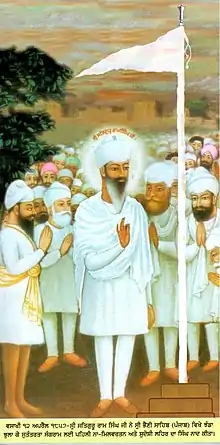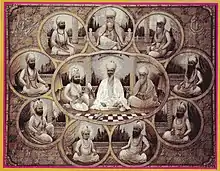Namdhari
The Namdharis are a separate Sikh sect that differs from mainstream Sikhs in the belief that the lineage of Sikh Gurus did not end with Guru Gobind Singh. They believe that Guru Gobind Singh stealthily escaped the burning tent in Nanded, and secretly helped the Khalsa in the coming decades under the guise of Baba Ajaypal Singh.[1] According to their beliefs, Guru Gobind Singh passed guruship to Satguru Balak Singh of Hazro, Punjab in the year 1812 on Baisakh Sudi 10.[2] Therefore, they recognize Satguru Balak Singh as the 11th Guru of the Sikh religion, thus continuing the succession of Sikh Gurus through the centuries from Guru Nanak Dev Ji to Namdhari Satguru Jagjit Singh. [3] Guru Gobind Singh shortly retired from this world leaving his earthly body on Jeth Sudi 5, Vikrami Samvat 1869 (1812 A.D.). The 12th Guru is Satguru Ram Singh, who moved the sects centre to Bhaini Sahib (Ludhiana) and is regarded as the first Indian to use non-cooperation and non-violence boycott in order to combat the tyrannous British Empire in India, [4] while being an advocate for women's rights, and reviving the failing Khalsa traditions of Guru Gobind Singh.
| Part of a series on |
| Sikhism |
|---|
 |
They have been strictly vegetarian and a strong opponent of cattle slaughter and retaliated against Muslims for killing cows in 1872. Satguru Ram Singh was arrested by the British and he was exiled to Rangoon, Myanmar and later to Mergui. Dozens of Namdharis were arrested by the British and executed without trial in Ludhiana and Ambala. They consider Guru Granth Sahib and Dasam Granth as equally important, and compositions from the Chandi di Var are a part of their daily Nitnem. They circumambulate the fire (havan) during their weddings, but they differ in that the hymns are those from the Adi Granth. The Namdharis wear homespun white turbans, which they wrap around their heads (sidhi pagri). They are called Kuka, which means "crier, shouter", for their ecstatic religious practices during devotional singing. They also meditate, using mala (rosary).[5] Some texts refer to them as Jagiasi or Abhiasi, which is a term specifically referring to the Sikhs of Satguru Balak Singh.
Role in Indian freedom movement
The Namdharis are recognized as freedom fighters due to their attacks on Cow slaughters, inflicting death on Muslim butchers in Amritsar and Ludhiana in Vikrami Samvat 1928 at midnight on 15 July 1871. The British had instituted a kine slaughter house near the holy Golden Temple Amritsar on 5 May 1849, where crows would grab the bones of slaughtered cows and drop them within the holy tank of Amritsar.[6] 4 Namdhari Sikhs Bhai Lehna Singh, Bhai Fateh Singh, Bhai Hakam Singh Patwari, Bhai Beehla Singh took this burden onto their shoulders and killed the butchers and freed the cows.[7] As a result, the mentioned Sikhs were sentenced to death by hanging at Ram Bagh, Amritsar, where at present, a Namdhari Shaheedi Samarak (memorial) is placed in their honor. [8][9]
A group of 66 Namdhari Sikhs were blown up by cannons on 17-18 January 1872 for protesting against the British and one 12-year-old boy (Bishan Singh) was beheaded by sword on the same day in Maler Kotla; there is a memorial to them at Namdhari Shidi Smarg Malerkotla in Indian Punjab.[10] Mr. Cowan urged the 12 year old boy Bishan Singh to renounce Satguru Ram Singh to save his life, however the boy on hearing these words grabbed the long beard of Mr. Cowan so tightly that the nearby officers cut his neck and hands off to save him. [11] The British government in retaliation to the actions of Mr. Cowan murdering 66 Namdhari Sikhs without proper trial or sentencing was removed from the British ranks shortly thereafter. [12] Satguru Ram Singh was sent to Allahabad with his servant (Nanu Singh) on 18 January 1872, in the morning hours from Ludhiana by a special train.[13] On 10 March 1872, Satguru Ram Singh was shifted to Calcutta. On 11 March 1872 he was sent to Rangoon in British Burma. [14] [15] Satguru Ram Singh was kept there until 18th September 1880, and then shifted to Megui in Burma, in an attempt to make contact with him more difficult. [16][17]

Even in exile, Satguru Ram Singh worked endlessly to keep the freedom struggle alive even sending his Suba (Lieutenant) Bishan Singh to Moscow, in order to gain the support of Czar Nicholas II of Russia, in removing British rule in India. Suba Bishan had made contact with Maharaja Duleep Singh who was also in Moscow at the time looking to gain support of the Russian Czar in order to rid the British from India, and re-institute the once flourishing Sikh Empire. However, due to the Russian-Turkish War (1877-1878) the Russians were not keen on supporting any Indian nationalist in going to war against the British Empire.[18] [19]
Sant Khalsa
On the day of Baisakhi, 13 April 1857, for the propagation of the teachings of the Sikh Gurus and to revive the fallen Khalsa of Guru Gobind Singh, Satguru Ram Singh began to bring the people back into Sikhism. He administered Khande di Pahul (Amrit Sanchar) to 5 Sikhs: Kahn Singh Nihang of village Chak, Labh Singh Ragi of Amritsar, Atma Singh of Alo Muhar village, Bhai Naina Singh Wariyah, and Sudh Singh of village Durgapur. Afterwards, several people from the congregation took amrit. [20] It is noted within the Kuka British Archives as well as Giani Gian Singh's Panth Parkash that within 10 years Satguru Ram Singh baptized over 70,000 people with amrit.[21]
The followers of Satguru Ram Singh and initiates into the Sant Khalsa were known as Namdharis or Kukas. Writing about the Kuka life Major Perkins wrote in 1866 that "on initiation all vices are supposed to be foresworn such as lying, stealing, drinking, adultery, etc.". The general public adopted his teachings quite swiftly, as they are quite appealing and in-line with the original tenents of the Khalsa faith instituted by Guru Gobind Singh. Further appeal to join the Sant Khalsa came due to no-cost of receiving amrit, in contrast to general Sikhs and Nihangs of the time. "Kooka converts are put to no expense whereas converts to Sikhism are". Major Perkins further illustrates "... if the fifty men who have been converted to Kookaism during the fair had turned into Sikhs, the Nihungs would have benefited at least 50 rupees".
Line of Gurus recognised by Namdharis
Below are the names of Gurus followed by Namdhari Sikhs as mentioned on the sect's official website:[22]

- Guru Nanak Dev Ji
- Guru Angad Dev Ji
- Guru Amar Das Ji
- Guru Ram Das Ji
- Guru Arjan Dev Ji
- Guru Har Gobind Sahib Ji
- Guru Har Rai Sahib Ji
- Guru Har Krishan Sahib Ji
- Guru Tegh Bahadur Sahib Ji
- Guru Gobind Singh Ji
- Sri Satguru Balak Singh Ji
- Sri Satguru Ram Singh Ji
- Sri Satguru Hari Singh Ji
- Sri Satguru Partap Singh Ji
- Sri Satguru Jagjit Singh Ji
- Sri Satguru Dalip Singh Ji
References
- Gill, Davinder SIngh (1998). Naded Toun Baad Dasam Guru. Capco Printing. pp. 28–30.
- Singh, Giani Gian (1880). Sri Guru Panth Parkash Vol. 7. Punjab.
- Gill, Davinder Singh (1998). Nanded Toun Baad Dasam Guru. Punjab: Capco Printing. pp. 121–123.
- "Ram Singh Philosopher". Encyclopædia Britannica.
- Joginder Singh (Professor of history) (2010). A short history of Namdhari Sikhs of Punjab. Amritsar: Guru Nanak Dev University. ISBN 978-81-7770-156-2. OCLC 746619629.
- Sanehi, Swaran Singh. Foremost Freedom Fighters. Maden Head: Deportation Centenary Committee. p. 3.
- Further correspondence regarding the murder of butchers at Amritsar & Raikot in Ludhiana District: Judicial, B, August 1871 Nos. 26-32
- Henry Schwarz; Sangeeta Ray (2004). A companion to postcolonial studies. John Wiley & Sons. pp. 261–. ISBN 978-0-631-20663-7.
- Singh, Jaswinder. Great Namdhari Martyrs of Amritsar Episode.
- Singh, Bajinder Pal, 2005. After 133 years of anonymity, Kukar martyrs finally get a name
- Sanehi, Swaran Singh. Foremost Freedom Fighters. Maden Head: Deportation Centenary Committee. p. 12.
- Dispatch from Secretary of State approving of the dismissal of Mr. L. Cowan and of the orders issued in report to Mr. Forsyth. The grant of a pension to Mr. Cowan of Rs. 300/- per mansem sanctioned: Judicial, A, August 1872, No 246.
- Recent disturbances by Kookas in the Ludhiana District of the Punjab.: Judicial, A, 20 January 1872,Nos. 55-71
- Removal of Ram Singh, Kuka leader from Allahabad to British Burma.: Judicial, A, March 1872, Nos 111-112
- Removal of Ram Singh, the Kuka leader to British Burma.: Judicial A, May 1872, No. 122.
- Joginder Singh (Professor of history) (2010). Namdhari Guru Ram Singh. National Book Trust. (1st ed.). New Delhi: National Book Trust, India. ISBN 978-81-237-5918-0. OCLC 696603673.
- Kooka Chief Ram Singh in Rangoon: Judicial, A, May 1872, No.80
- Singh, Jaswinder (1985). Kuka Movement Freedom Struggle in Punjab. Punjab: Atlantic Publishers & Distributions. ISBN 9788171560813.
- Singh, M.A., Nahar. Gooroo Ram Singh & the Kuka Sikhs, Book III. Kamla Nagar, Delhi: R.K. Printers.
- Sanehi, Swaran Singh. Foremost Freedom Fighters. Maidenhead, Berks: Deportation Centenary Committee.
- Panth Parkash, Giani Gian Singh Vol.7
- "Namdhari Sikhs article on Namdhari Sect's official website". Sri Bhaini Sahib.